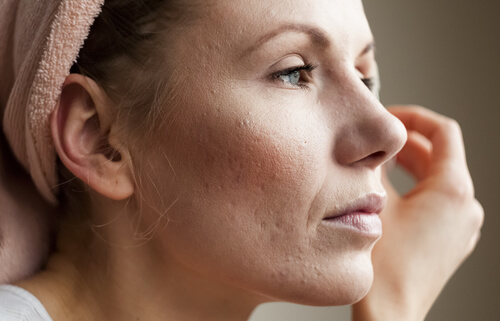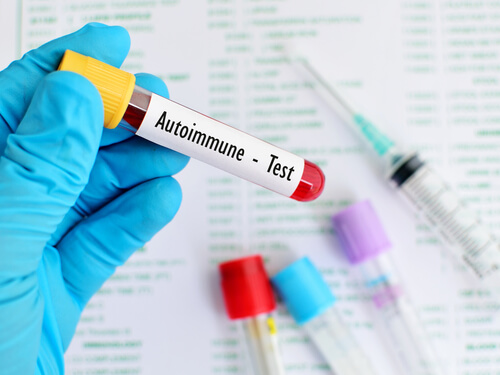六種身體產生高皮質醇的跡象

氫化皮質酮,或稱為皮質醇,是腎上腺所產生的一種荷爾蒙。過高的皮質醇指數會影響您的健康。
畢竟,皮質醇有助於增加我們的血糖值,但也能降低骨骼形成並導致肥胖等疾病。
當您的皮質醇指數過高時,這就是所謂的皮質醇增多症或庫興氏症候群(Cushing’s syndrome)。這種疾病會導致脂肪聚積、高血壓及巨大的身體壓力。
以下的這些跡象能幫助您知道您體內是否有過多的皮質醇:
1. 體重突然增加
體重增加是高皮質醇的首要症狀之一。
這在身體的上半部尤其明顯,因為脂肪開始積聚在肩膀,胸部和背部等地方。
然而最奇怪的是患者的手臂和腿部會持續變瘦。
2. 皮膚症狀

皮膚也會受到皮質醇增多症的影響。
它可能導致以下情況:
- 粉刺
- 乳房、腹部及大腿上的紫色病變
- 瘀青
- 臉部和身體的毛髮增加。
3. 肌肉骨骼症狀
高皮質醇也會影響肌肉和骨骼,骨骼的結構會變弱,導致增加骨折風險,尤其是肋骨和脊柱骨。
4. 免疫系統缺陷

調節人體免疫系統的胸腺也會受高皮質醇的影響。
高皮質醇會導致細胞死亡,並導致免疫系統攻擊身體組織而不是病毒。
- 最常見的免疫系統失效症狀是氣喘和過敏。
- 問題還可能變得更嚴重:可能導致狼瘡,克隆氏症(Crohn’s disease)或纖維肌痛症候群(fibromyalgia)。
5. 憂鬱和情緒波動
焦慮是當人承受過大壓力時最常出現的症狀之一。
並伴隨著同一天裡連續和突然的情緒波動,並且在某些案例下,可以看到嚴重的憂鬱跡象。
有研究指出,高皮質醇指數會降低血液流動和大腦的葡萄糖供應。
這干擾了我們的大腦細胞吸收葡萄糖的能力,並可能導致細胞死亡。
6. 疲勞及失眠

皮質醇提供的能量可能會對身體產生反向作用。
在這種情況下,白天身體會過於活躍不休息;夜晚,多餘的荷爾蒙不允許患者放鬆,讓他們飽受失眠的困擾。
- 在正常情況下,體內的皮質醇指數會於上午8點左右上升以提供能量。
- 但在皮質醇增多症的情形下,情況則相反,荷爾蒙於夜間活躍,而於白天耗盡。
如何降低體內皮質醇指數?
在這裡,我們介紹一些減少體內皮質醇指數的技巧,讓您獲到更健康的生活。
告別咖啡
咖啡因會在一小時內將血液中的皮質醇指數提高至少30%。但是,在某些情形下,效果可能持續18個小時。
如果您打算降低您的分解代謝力,並增加合成代謝力,請不要再喝咖啡。
嘗試睡的更多

在睡前喝洋甘菊茶或纈草茶等飲品來改善睡眠週期。這會讓你的身體更快入睡及睡得更久。
這樣做除了降低您體內的皮質醇指數外,您會看起來更年輕、更健康,並會縮小過去的影響。
運動
規律且定期的運動,這樣做的好處是可以獲得肌肉量及增加血清素和多巴胺,並可降低產生焦慮或憂鬱的風險
不只如此,運動還能燃燒掉體內聚積的多餘能量,並帶走您的皮質醇指數。
保持血糖指數穩定
吃完整的碳水化合物、蛋白質和纖維質充分的一餐,以控制你的糖指數。
並建議您服用營養補充品,如維生素B,鈣,鎂,鉻,鋅,維生素C和硫辛酸(ALA)。
氫化皮質酮,或稱為皮質醇,是腎上腺所產生的一種荷爾蒙。過高的皮質醇指數會影響您的健康。
畢竟,皮質醇有助於增加我們的血糖值,但也能降低骨骼形成並導致肥胖等疾病。
當您的皮質醇指數過高時,這就是所謂的皮質醇增多症或庫興氏症候群(Cushing’s syndrome)。這種疾病會導致脂肪聚積、高血壓及巨大的身體壓力。
以下的這些跡象能幫助您知道您體內是否有過多的皮質醇:
1. 體重突然增加
體重增加是高皮質醇的首要症狀之一。
這在身體的上半部尤其明顯,因為脂肪開始積聚在肩膀,胸部和背部等地方。
然而最奇怪的是患者的手臂和腿部會持續變瘦。
2. 皮膚症狀

皮膚也會受到皮質醇增多症的影響。
它可能導致以下情況:
- 粉刺
- 乳房、腹部及大腿上的紫色病變
- 瘀青
- 臉部和身體的毛髮增加。
3. 肌肉骨骼症狀
高皮質醇也會影響肌肉和骨骼,骨骼的結構會變弱,導致增加骨折風險,尤其是肋骨和脊柱骨。
4. 免疫系統缺陷

調節人體免疫系統的胸腺也會受高皮質醇的影響。
高皮質醇會導致細胞死亡,並導致免疫系統攻擊身體組織而不是病毒。
- 最常見的免疫系統失效症狀是氣喘和過敏。
- 問題還可能變得更嚴重:可能導致狼瘡,克隆氏症(Crohn’s disease)或纖維肌痛症候群(fibromyalgia)。
5. 憂鬱和情緒波動
焦慮是當人承受過大壓力時最常出現的症狀之一。
並伴隨著同一天裡連續和突然的情緒波動,並且在某些案例下,可以看到嚴重的憂鬱跡象。
有研究指出,高皮質醇指數會降低血液流動和大腦的葡萄糖供應。
這干擾了我們的大腦細胞吸收葡萄糖的能力,並可能導致細胞死亡。
6. 疲勞及失眠

皮質醇提供的能量可能會對身體產生反向作用。
在這種情況下,白天身體會過於活躍不休息;夜晚,多餘的荷爾蒙不允許患者放鬆,讓他們飽受失眠的困擾。
- 在正常情況下,體內的皮質醇指數會於上午8點左右上升以提供能量。
- 但在皮質醇增多症的情形下,情況則相反,荷爾蒙於夜間活躍,而於白天耗盡。
如何降低體內皮質醇指數?
在這裡,我們介紹一些減少體內皮質醇指數的技巧,讓您獲到更健康的生活。
告別咖啡
咖啡因會在一小時內將血液中的皮質醇指數提高至少30%。但是,在某些情形下,效果可能持續18個小時。
如果您打算降低您的分解代謝力,並增加合成代謝力,請不要再喝咖啡。
嘗試睡的更多

在睡前喝洋甘菊茶或纈草茶等飲品來改善睡眠週期。這會讓你的身體更快入睡及睡得更久。
這樣做除了降低您體內的皮質醇指數外,您會看起來更年輕、更健康,並會縮小過去的影響。
運動
規律且定期的運動,這樣做的好處是可以獲得肌肉量及增加血清素和多巴胺,並可降低產生焦慮或憂鬱的風險
不只如此,運動還能燃燒掉體內聚積的多餘能量,並帶走您的皮質醇指數。
保持血糖指數穩定
吃完整的碳水化合物、蛋白質和纖維質充分的一餐,以控制你的糖指數。
並建議您服用營養補充品,如維生素B,鈣,鎂,鉻,鋅,維生素C和硫辛酸(ALA)。
- Amasi-Hartoonian, N., Sforzini, L., Cattaneo, A., & Pariante, C. M. (2022). Cause or consequence? Understanding the role of cortisol in the increased inflammation observed in depression. Current Opinion in Endocrine and Metabolic Research, 24, 100356. https://www.ncbi.nlm.nih.gov/pmc/articles/PMC7612780/
- Çay, M. (2017). The Effect of Cortisol Level Increasing Due to Stress in Healthy Young Individuals on Dynamic and Static Balance Scores. Northern Clinics of Istanbul. https://pubmed.ncbi.nlm.nih.gov/30859159/
- Chen, Y., & Lyga, J. (2014). Brain-Skin Connection: Stress, Inflammation and Skin Aging. Inflammation & Allergy-Drug Targets, 13(3), 177-190. https://www.ncbi.nlm.nih.gov/pmc/articles/PMC4082169/
- Chiodini, I., Scillitani, A. (2008). Role of cortisol hypersecretion in the pathogenesis of osteoporosis. Recenti Prog Med, 99(6), 309-13. https://pubmed.ncbi.nlm.nih.gov/18710063/
- Choe, S. J., Kim, D., Kim, E. J., Ahn, J. S., Choi, E. J., Son, E. D., Lee, T. R., & Choi, E. H. (2018). Psychological Stress Deteriorates Skin Barrier Function by Activating 11β-Hydroxysteroid Dehydrogenase 1 and the HPA Axis. Scientific Reports, 8(1). https://www.ncbi.nlm.nih.gov/pmc/articles/PMC5910426/
- Cuevas, G. S. (2016). La ansiedad y el estrés, nuestros peores enemigos. La Mente es Maravillosa. Consultado el 28 de septiembre de 2023. https://lamenteesmaravillosa.com/la-ansiedad-estres-peores-enemigos/
- Dziurkowska, E., & Wesolowski, M. (2021). Cortisol as a Biomarker of Mental Disorder Severity. Journal of Clinical Medicine, 10(21), 5204. https://www.ncbi.nlm.nih.gov/pmc/articles/PMC8584322/
- DiNicolantonio, J. J., Mehta, V., Onkaramurthy, N., & O’Keefe, J. H. (2018). Fructose-induced inflammation and increased cortisol: A new mechanism for how sugar induces visceral adiposity. Progress in Cardiovascular Diseases, 61(1), 3-9. https://pubmed.ncbi.nlm.nih.gov/29225114/
- Hackett, R. A., Dal, Z., & Steptoe, A. (2020). The relationship between sleep problems and cortisol in people with type 2 diabetes. Psychoneuroendocrinology, 117. https://www.ncbi.nlm.nih.gov/pmc/articles/PMC7302424/
- Haddad, C., Courand, P. Y., Berge, C., Harbaoui, B., & Lantelme, P. (2021). Impact of cortisol on blood pressure and hypertension-mediated organ damage in hypertensive patients. Journal of Hypertension, 39(7), 1412-1420. https://pubmed.ncbi.nlm.nih.gov/33534343/
- Hertel, J., König, J., Homuth, G., Van der Auwera, S., Wittfeld, K., Pietzner, M., Kacprowski, T., Pfeiffer, L., Kretschmer, A., Waldenberger, M., Kastenmüller, G., Artati, A., Suhre, K., Adamski, J., Langner, S., Völker, U., Völzke, H., Nauck, M., Friedrich, N., & Grabe, H. J. (2017). Evidence for Stress-like Alterations in the HPA-Axis in Women Taking Oral Contraceptives. Scientific Reports, 7(1). https://www.nature.com/articles/s41598-017-13927-7
- Hewagalamulage, S., Lee, T., Clarke, I., & Henry, B. (2016). Stress, cortisol, and obesity: a role for cortisol responsiveness in identifying individuals prone to obesity. Domestic Animal Endocrinology, 56, S112-S120. https://pubmed.ncbi.nlm.nih.gov/27345309/
- Kamba, A., Daimon, M., Murakami, H., Otaka, H., Matsuki, K., Sato, E., Tanabe, J., Takayasu, S., Matsuhashi, Y., Yanagimachi, M., Terui, K., Kageyama, K., Tokuda, I., Takahashi, I., & Nakaji, S. (2016). Association between Higher Serum Cortisol Levels and Decreased Insulin Secretion in a General Population. PLOS ONE, 11(11), e0166077. https://www.ncbi.nlm.nih.gov/pmc/articles/PMC5115704/
- Jones, C., & Gwenin, C. (2020). Cortisol level dysregulation and its prevalence—Is it nature’s alarm clock? Physiological Reports, 8(24). https://pubmed.ncbi.nlm.nih.gov/33340273/
- Lovallo, W. R., Whitsett, T. L., al’Absi, M., Sung, B. H., Vincent, A. S., & Wilson, M. F. (2005). Caffeine Stimulation of Cortisol Secretion Across the Waking Hours in Relation to Caffeine Intake Levels. Psychosomatic Medicine, 67(5), 734-739. https://www.ncbi.nlm.nih.gov/pmc/articles/PMC2257922/
- Lee, D. Y., Kim, E., & Choi, M. H. (2015). Technical and clinical aspects of cortisol as a biochemical marker of chronic stress. BMB Reports, 48(4), 209-216. https://www.ncbi.nlm.nih.gov/pmc/articles/PMC4436856/
- Paragliola, R. M., Corsello, A., Papi, G., Pontecorvi, A., & Corsello, S. M. (2021). Cushing’s Syndrome Effects on the Thyroid. International Journal of Molecular Sciences, 22(6), 3131. https://pubmed.ncbi.nlm.nih.gov/33808529/
- Peeters, G. M. E. E., van Schoor, N. M., van Rossum, E. F. C., Visser, M., & Lips, P. (2008). The relationship between cortisol, muscle mass and muscle strength in older persons and the role of genetic variations in the glucocorticoid receptor. Clinical Endocrinology, 69(4), 673-682. https://www.ncbi.nlm.nih.gov/pmc/articles/PMC7302424/
- Thau L, Gandhi J, Sharma S. Physiology, Cortisol. In: StatPearls [Internet]. Treasure Island (FL): StatPearls Publishing; 2022 Jan-. Available from: https://www.ncbi.nlm.nih.gov/books/NBK538239/
- Uwaifo GI, Hura DE. Hypercortisolism. [Updated 2022 Jul 4]. In: StatPearls [Internet]. Treasure Island (FL): StatPearls Publishing; 2022 Jan-. Available from: https://www.ncbi.nlm.nih.gov/books/NBK551526/
- Vargas, I., Vgontzas, A. N., Abelson, J. L., Faghih, R. T., Morales, K. H., & Perlis, M. L. (2018). Altered ultradian cortisol rhythmicity as a potential neurobiologic substrate for chronic insomnia. Sleep Medicine Reviews, 41, 234-243. https://pubmed.ncbi.nlm.nih.gov/29678398/
- Walter, K. N., Corwin, E. J., Ulbrecht, J., Demers, L. M., Bennett, J. M., Whetzel, C. A., & Klein, L. C. (2012). Elevated thyroid stimulating hormone is associated with elevated cortisol in healthy young men and women. Thyroid research, 5(1), 1-6. https://link.springer.com/article/10.1186/1756-6614-5-13
- Woldeamanuel, Y. W., Sanjanwala, B. M., & Cowan, R. P. (2020). Endogenous glucocorticoids may serve as biomarkers for migraine chronification. Therapeutic Advances in Chronic Disease, 11, 204062232093979. https://www.ncbi.nlm.nih.gov/pmc/articles/PMC7495027/
此文本僅供資訊目的使用,並不取代與專業人士的諮詢。如有疑問,請諮詢您的專家。







